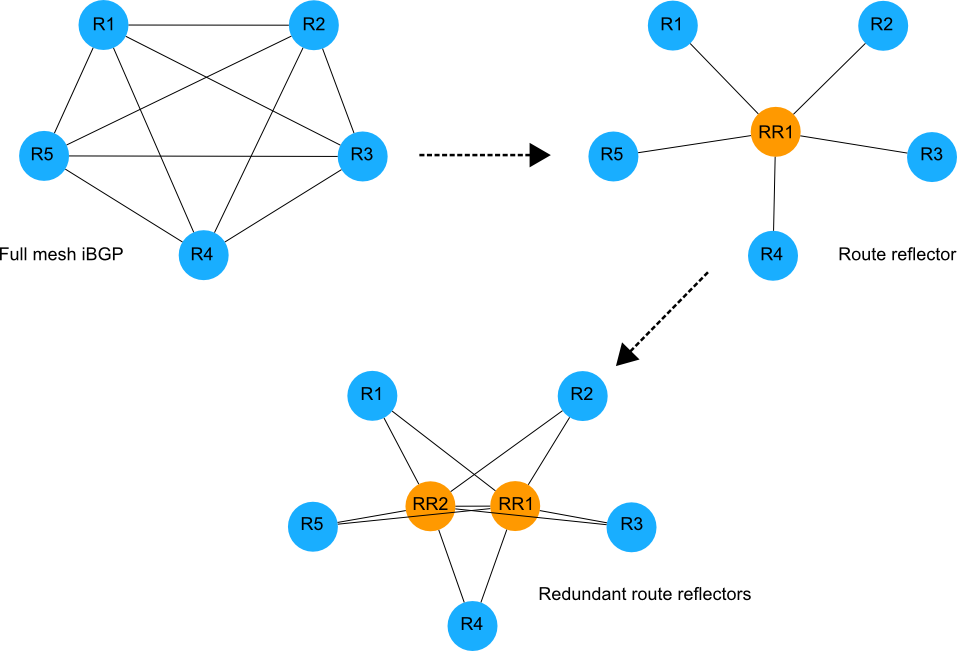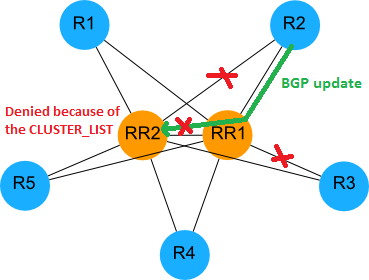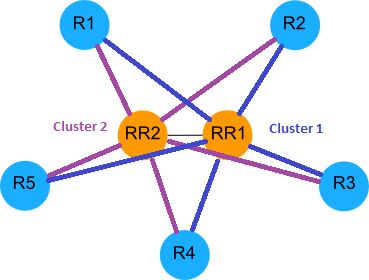Simple BGP Route reflectors redundancy
The purpose of this article is to set up redundant iBGP Route Reflectors.

A route reflector is designed to lower the complexity level of iBGP networks that usually require full mesh. Route reflectors allow you to break a basic iBGP rule: pass an internal BGP route to another iBGP peer. This will imply the use of two new BGP attributes: CLUSTER_LIST and ORIGINATOR_ID.
iBGP mesh formula:
total(connections) = r(r-1)/2, where r are routers
A small ISP with 10 routers:
total = 10(10-1)/2
total = 45 connections
An iBGP cluster is made of: one or several route reflectors and its clients. This concept of cluster is done to create advanced and hierarchical design in complex long distance BGP deployments.
A route reflector can have three types of peers (2 internals + 1 external):
– EBGP (different ASN)
– client (with the route-reflector-client command)
– non-client (simple iBGP peer)
These relationships comply with the following rules:
– EBGP routes are sent to EBGP peers, clients and non-clients
– client routes are announced to EBGP peers, clients and non-clients
– non-client routes are reflected to all clients and EBGP peers but not non-clients (iBGP rule)
So, why setup two redundant RRs ?
Because RRs have an important and central role in a iBGP network, having just one RRs is a single point of failure.
Two new BGP attributes are brought by the RFC 4456 – Route Reflection.
CLUSTER_LIST (optional, non-transitive)
The CLUSTER_LIST represents the reflection path (= all the RRs that the route went through). Each RR prepends its CLUSTER_ID in the CLUSTER_LIST. This attribute prevents loops between clusters. It is useful in BGP designs that involves multiple clusters and multiple RRs.
ORIGINATOR_ID (optionnal, non-transitive)
It indicates the router-id of the neighbor from which the route was learnt. It is a loop prevention mechanism (recall that route reflection breaks the iBGP loop prevention rule). When a route is received by a router, the ORIGINATOR_ID is compared with the local router-id and if they are the same, the route is ignored (that’s why it is important to keep router IDs unique in a domain…).
Note that these two new attributes are added by route reflectors.
Now, let’s configure our network (configurations are available below):
RR1
router bgp 65001
no synchronization
bgp router-id 111.111.111.111
bgp log-neighbor-changes
neighbor RRCLI peer-group
neighbor RRCLI remote-as 65001
neighbor RRCLI update-source Loopback0
neighbor RRCLI route-reflector-client
neighbor RRCLI soft-reconfiguration inbound
neighbor 1.1.1.1 peer-group RRCLI
neighbor 2.2.2.2 peer-group RRCLI
neighbor 3.3.3.3 peer-group RRCLI
neighbor 4.4.4.4 peer-group RRCLI
neighbor 5.5.5.5 peer-group RRCLI
neighbor 222.222.222.222 remote-as 65001
neighbor 222.222.222.222 update-source Loopback0
neighbor 222.222.222.222 soft-reconfiguration inbound
no auto-summary
A route reflector client (R4)
router bgp 65001
no synchronization
bgp router-id 4.4.4.4
bgp log-neighbor-changes
network 49.49.49.0 mask 255.255.255.0
neighbor REDRR peer-group
neighbor REDRR remote-as 65001
neighbor REDRR update-source Loopback0
neighbor REDRR soft-reconfiguration inbound
neighbor 111.111.111.111 peer-group REDRR
neighbor 222.222.222.222 peer-group REDRR
no auto-summary
If the CLUSTER_ID is not set with the command bgp cluster-id, the IOS will take the router-id value. If you want two RRs in a cluster you will need to modify this value to a common value (e.g.: bgp cluster-id 1). However this creates a problem in a particular scenario where multiple failures occur.
So, in order to ensure RRs redundancy, the most widely-employed solution is to set two iBGP clusters.
The problem
##RR1
router bgp 65001
bgp cluster-id 1
neighbor 3.3.3.3 shutdown
##RR2
router bgp 65001
bgp cluster-id 1
neighbor 2.2.2.2 shutdown
R2 still has a peering with RR1 and R3 still has a peering with RR2. Does each other see their prefixes 29.29.29.0 and 39.39.39.0 ?
R2#sh ip route bgp
49.0.0.0/24 is subnetted, 1 subnets
B 49.49.49.0 [200/0] via 4.4.4.4, 00:26:32
19.0.0.0/24 is subnetted, 1 subnets
B 19.19.19.0 [200/0] via 1.1.1.1, 00:26:32
59.0.0.0/24 is subnetted, 1 subnets
B 59.59.59.0 [200/0] via 5.5.5.5, 00:26:32
R2#sh ip bgp neighbors 111.111.111.111 advertised-routes
BGP table version is 51, local router ID is 2.2.2.2
Status codes: s suppressed, d damped, h history, * valid, > best, i - internal,
r RIB-failure, S Stale
Origin codes: i - IGP, e - EGP, ? - incomplete
Network Next Hop Metric LocPrf Weight Path
*> 29.29.29.0/24 0.0.0.0 0 32768 i
Total number of prefixes 1
R3#sh ip route bgp
49.0.0.0/24 is subnetted, 1 subnets
B 49.49.49.0 [200/0] via 4.4.4.4, 00:01:41
19.0.0.0/24 is subnetted, 1 subnets
B 19.19.19.0 [200/0] via 1.1.1.1, 00:01:41
59.0.0.0/24 is subnetted, 1 subnets
B 59.59.59.0 [200/0] via 5.5.5.5, 00:01:41
R3#sh ip bgp neighbors 222.222.222.222 adver
BGP table version is 53, local router ID is 3.3.3.3
Status codes: s suppressed, d damped, h history, * valid, > best, i - internal,
r RIB-failure, S Stale
Origin codes: i - IGP, e - EGP, ? - incomplete
Network Next Hop Metric LocPrf Weight Path
*> 39.39.39.0/24 0.0.0.0 0 32768 i
Total number of prefixes 1
No. Still advertised but not propagated. Why ? Because of the CLUSTER_LIST attribute. If a router sees its CLUSTER_ID inside the CLUSTER_LIST it will think there is a loop and will ignored the route, breaking our redundancy. So setting the same cluster-id on two RRs is a bad idea !

The solution
##RR1
router bgp 65001
bgp cluster-id 1
neighbor 3.3.3.3 shutdown
##RR2
router bgp 65001
bgp cluster-id 2
neighbor 2.2.2.2 shutdown
R2#sh ip bgp 39.39.39.0
BGP routing table entry for 39.39.39.0/24, version 60
Paths: (1 available, best #1, table Default-IP-Routing-Table)
Not advertised to any peer
Local, (received & used)
3.3.3.3 (metric 3) from 111.111.111.111 (111.111.111.111)
Origin IGP, metric 0, localpref 100, valid, internal, best
Originator: 3.3.3.3, Cluster list: 0.0.0.1, 0.0.0.2
R3#sh ip bgp 29.29.29.0
BGP routing table entry for 29.29.29.0/24, version 62
Paths: (1 available, best #1, table Default-IP-Routing-Table)
Not advertised to any peer
Local, (received & used)
2.2.2.2 (metric 3) from 222.222.222.222 (222.222.222.222)
Origin IGP, metric 0, localpref 100, valid, internal, best
Originator: 2.2.2.2, Cluster list: 0.0.0.2, 0.0.0.1

Check the routes received by a RR:
R4#sh ip bgp 19.19.19.0
BGP routing table entry for 19.19.19.0/24, version 58
Paths: (2 available, best #2, table Default-IP-Routing-Table)
Flag: 0x820
Not advertised to any peer
Local, (received & used)
1.1.1.1 (metric 3) from 222.222.222.222 (222.222.222.222)
Origin IGP, metric 0, localpref 100, valid, internal
Originator: 1.1.1.1, Cluster list: 0.0.0.2
Local, (received & used)
1.1.1.1 (metric 3) from 111.111.111.111 (111.111.111.111)
Origin IGP, metric 0, localpref 100, valid, internal, best
Originator: 1.1.1.1, Cluster list: 0.0.0.1
R4#sh ip route 19.19.19.0
Routing entry for 19.19.19.0/24
Known via "bgp 65001", distance 200, metric 0, type internal
Last update from 1.1.1.1 00:32:56 ago
Routing Descriptor Blocks:
* 1.1.1.1, from 111.111.111.111, 00:32:56 ago
Route metric is 0, traffic share count is 1
AS Hops 0
Note that the RR does not change the next-hop. Consenquently you need to run an IGP to ensure the connectivity.
Download configuration files here
Links
http://www.juniper.net/techpubs/software/erx/erx41x/swconfig-routing-vol2/html/bgp-config13.html
http://www.pacnog.org/pacnog2/track2/routing/b2-1up.pdf"
http://wiki.nil.com/BGP_route_reflectors
RFC 4456 – BGP Route Reflection